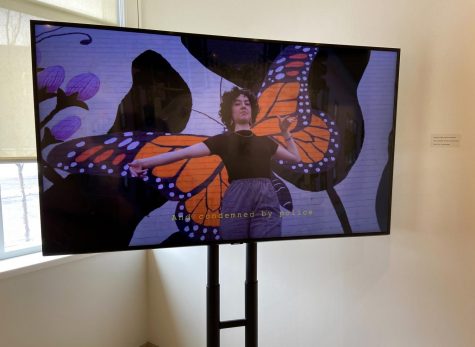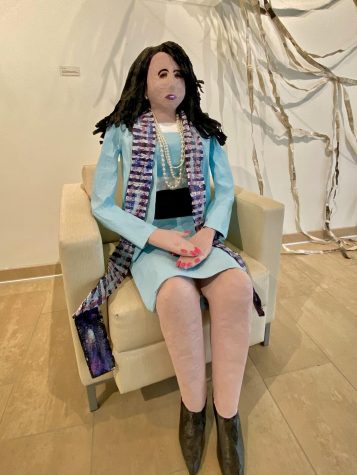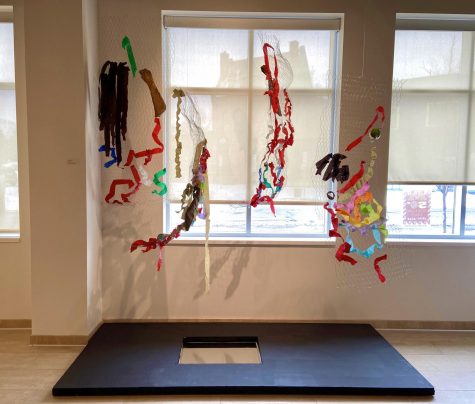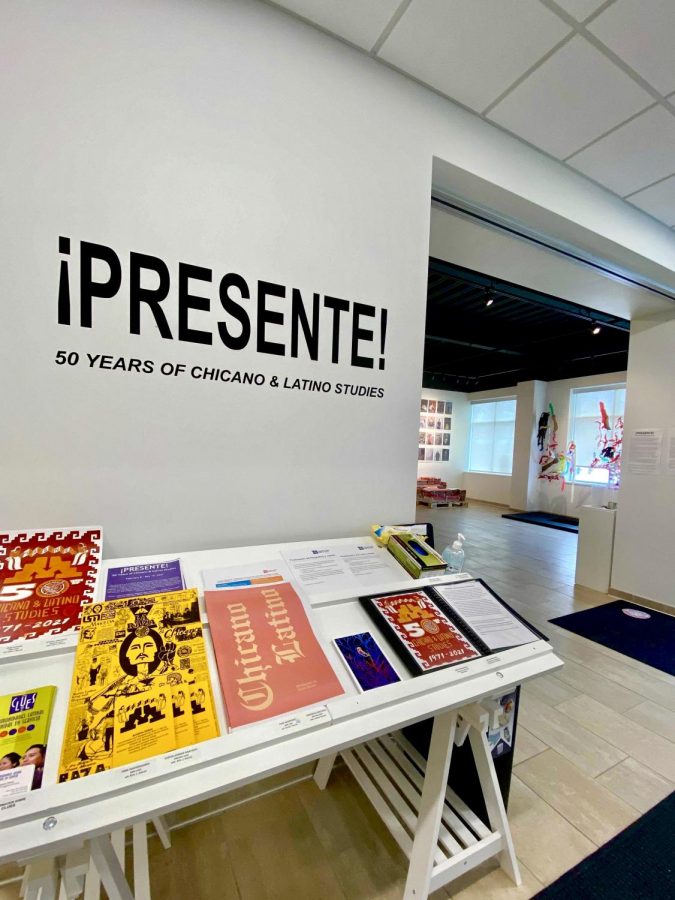Third-year University of Minnesota Ph.D. student Kiara Padilla spent eight hours at the University’s Elmer L. Andersen Library combing through boxes of historical documents to share with artists in an exhibition for the 50th anniversary of the University’s Department of Chicano and Latino Studies.
The historical documents will be used for inspiration for the artists to create artwork to showcase in the exhibition.
Padilla said she joined when she heard about the opportunity to be part of a team to fulfill a student’s vision and project for creating an exhibit inspired by the department’s history.
By the end of the fall semester, she was the only student with access to the University’s archives because other students had left campus. For two days, Padilla said she went through four or five boxes of thick folders to scan the documents that artists were interested in with her iPhone from 8 a.m. to noon.
The first event for the 50th anniversary is an exhibition called “¡Presente!: 50 Years of Chicano & Latino Studies,” honoring the history of the department and celebrating scholarship and community involvement. The exhibition is in collaboration with Comunidades Latinas Unidas en Servicio (CLUES) in St. Paul and the University’s Heritage Studies and Public History program.
Following the exhibition, the department will host more events throughout the spring and upcoming fall semester. Other events include an alumni event, a lecture series with Ramona Arreguin de Rosales and an event with La Raza Latinx Student Cultural Center.
“I think that the exhibit itself is really a collaboration between all these different voices and what they really envision [the] Chicano Latino studies to be and have been,” Padilla said. “But I think, also where we see Chicano Latino studies going. I think that’s really important.”
The vision of the exhibition formed when Ernesto Moreno, a recent University graduate, was an intern at the Department of Chicano and Latino Studies. Moreno said in his internship he cataloged historical documents collected by faculty and staff over the years as part of his capstone course at the University’s Heritage Studies and Public History program. He added that his capstone thesis centered on making archives more accessible and engaging.
During his internship, he also attended a Chicanx art class, sparking his vision for artists using the historical material to inspire their art, he said.
“It came from the whole idea being a way to show that the [Latinx] community in the Twin Cities is not something that was in the past and it’s not something that is nonexistent,” Moreno said. “It was a way to show that not only is there a community there but that it’s one that’s creative, … that has a history, at the same time.”
The exhibition is located at CLUES and will be open to the public by online appointment until May 16. The art is created by Chicano and Latino artists, featuring historical documents, a film with dance and poetry, an art installation, portraits and more.
“I feel like there’s this whole conception that an archive is something that is meant to be in a basement somewhere, just collecting dust, and we have to preserve history for the sake of preserving,” Moreno said. “And it’s like, well, there’s no point in having an archive if no one’s ever going to read it.”
The “¡Presente!: 50 Years of Chicano & Latino Studies” exhibition
CLUES is the largest Latino-led nonprofit organization to advance social and economic support for Latinos in Minnesota. The organization partnered with the department by providing gallery space to feature the artwork of six commissioned artists and two artist teams.
“I was really excited that I got in and I knew that the people that would see this art would be people that understand me and understand underrepresented artists in communities,” Alondra Garza, one of the artists in the exhibit, said. She added that she rarely finds paid opportunities for her artwork to be kept in a collection and align so closely with her heritage.

Luisa Armendariz and Margaret Ogas collaborated to create a short film for the exhibition, called “Rise y Resiste: 50 Years of Movimiento,” that they said highlights a poem that they felt reflects current and past movements of struggle.
“We wanted to highlight how things feel very much the same in many ways but modernize them in the movements that are happening in 2020,” Armendariz said. “Also, just the intersection of both Black and brown communities because it was important for us to show that our struggles are intertwined in so many ways.”
Overall, it took three years to plan and develop the exhibit with a team of students as well as staff members. In a partnership with the University’s Liberal Arts Technologies and Innovation Services, the exhibition will be virtual and available online in May.
“What I tried to do with the exhibition [is] illuminate the history of the department through the arts because I knew that students were absolutely critical in getting the department started. It wasn’t [administrators]; it was students,” said Karen Mary Davalos, the Chicano and Latino Studies department chair. “Their interest and work with the community are what moved us to new arrangements every single time there was change.”
Honoring the history
A sculpture of Ramona Arreguin de Rosales, created by artist Flor Soto, sits in the exhibition, facing the visitors as they enter. Rosales formed the Latin Liberation Front, a University student group, in 1969, and she served as president. In 1971, the group led a takeover of Morrill Hall, demanding that the University create a Chicano studies department within 72 hours.
The pressure and activism by the student group were inspired by student leaders who led to the establishment of the African American Studies department and the American Indian Studies department in 1969.
“It’s those moments of activism that are so valuable for us to remember,” said Jessica Lopez Lyman, Chicano and Latino Studies assistant professor. “Because not only do they set historic precedence but also guide future students on how to shape the University to make it a more just place.”

After a two-hour meeting with University officials, students said that if there was no concrete evidence for the establishment of a Chicano studies department within 72 hours, they would take a vote to strike against the University.
As a result, the University agreed to establish a Chicano studies department, and the department held classes in the fall semester that followed. The Department of Chicano Studies eventually changed its name to represent the increase of students from South and Central America, according to the Minnesota Historical Society.
Early in Rosales’ college career, she could identify 30 Chicano and Latino students on campus. But when she graduated, she remembers that there were around 300 Chicano and Latino students, she said.
“I felt the personal responsibility that I was committed to enlightening the University of Minnesota of their responsibility to the Chicano Latino-x community,” Rosales said.
When she graduated from the University, Rosales went on to support Chicano and Latino communities in Minnesota. She was the director of the Hispanic Pre-College Project, an outreach program at the University of St. Thomas. In response to the success of the program, families and community members requested a school to focus on Latino culture, cover educational needs and best practices of Latino communities.
In 2000, she founded the Academia Cesar Chavez School located in St. Paul. Currently, she is retired from her role as executive director but continues being a leader, activist and educator for Latino communities.
“I celebrate the success; I celebrate those people that came after me that have continued to stay committed to [the cause] for the department,” Rosales said.
Moving forward
As the first of its kind in the Upper Midwest, the Department of Chicano and Latino Studies has contributed to the community through collaborations and engagement during its 50 years. The department’s staff, faculty, alumni and students are advancing academic Chicano and Latino studies.
Yet, the department has only five faculty and just three are completely appointed in the department; the other two are joint appointments split with different departments. Davalos said her vision is to create an infrastructure to strengthen the foundation of the department that should have already been in place.
“This is not a critique of my colleagues who had struggled up into this point. It’s a reality. It’s an infrastructural disadvantage that the University of Minnesota created and continues to create,” Davalos said. “I’m the single full professor in the department, which is ridiculous for an interdisciplinary field.”

As one of the smallest departments at the University of Minnesota, faculty members carry added responsibilities that weigh on their capacity to devote to teaching and research, Lopez Lyman said.
“Our department was not given adequate resources from the beginning. We were never established to reach our potential as a discipline,” Lopez Lyman said. “But I’m very hopeful that the four of us as faculty, as well as potentially getting more faculty, will be able to meet the expectations of our field and also now align with other departments.”
Lisa Sass Zaragoza is the outreach coordinator and an instructor for the Department of Chicano and Latino Studies. She has been a staff member since 2005.
“I put my hand over my heart because while what we do in the department is, in my perspective, academic and intellectual, it is also intensely interpersonal and almost spiritual,” Sass Zaragoza said in an email. “It is head and heart.”



















